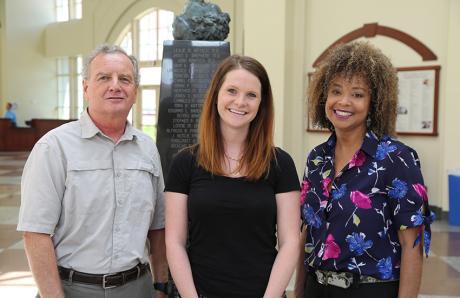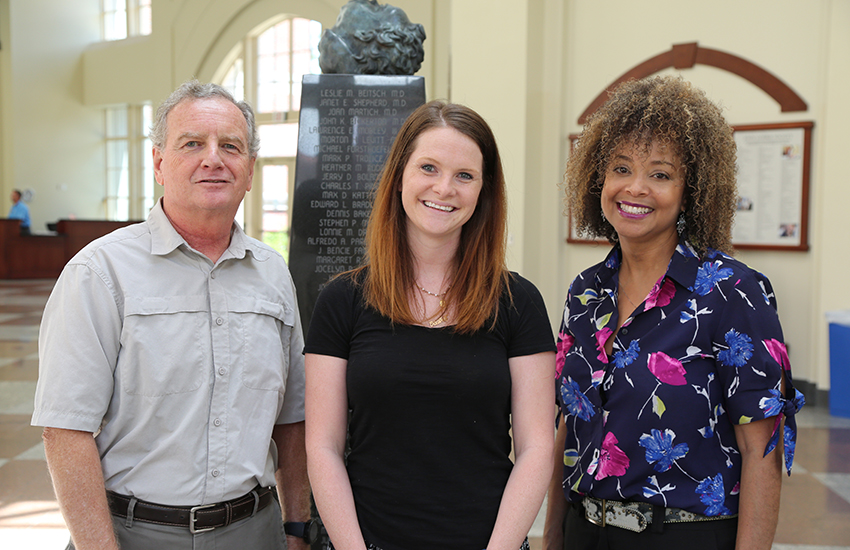Another sign of progress in fight for better births


Aug. 20, 2018
For the second year in a row, a research team in the College of Medicine has published a paper with a message of hope regarding racial disparities in newborns’ health.
“Our entire goal in our research is to dispel the myth that black mothers and infants are somehow inevitably doomed to have twice the worsening outcome of white mothers and infants,” said Assistant Professor Samantha Goldfarb, lead author of the paper published July 31 in PLoS One. “That’s just not true.”
The paper is “Pockets of progress amidst persistent racial disparities in low birthweight rates.” Goldfarb and co-authors Kelsey Houser, Brittny Wells, Joedrecka Brown Speights, Les Beitsch and George Rust assessed 11 years’ worth of reports on low-birthweight babies in more than 400 U.S. counties. (All but one are with the Department of Behavioral Sciences and Social Medicine. Brown Speights is interim chair of the Department of Family Medicine and Rural Health.)
At one end of the spectrum, they found 373 counties with persistent black-white disparities. But at the other end, they found four counties with shrinking racial disparities as well as reductions in the black low-birthweight rate.
Goldfarb acknowledges that four is a tiny number. On the other hand, that’s four more counties than she and her colleagues knew of beforehand. That’s four counties they can explore in future studies, in search of conditions that other counties might be able to replicate.
“One potential pathway discussed in the paper is chronic stress and perceived discrimination,” she said. “Are these factors that are more prevalent in certain parts of the country than others? I think this paper allows us to zoom in on certain areas and look for potential answers.”
The four counties that saw decreases in low-birthweight rates among blacks were Craighead County, Arkansas; Delaware County, Indiana; Black Hawk County, Iowa; and Stearns County, Minnesota.
Last year’s paper, published in the American Journal of Public Health, assessed state-level differences in black and white infant mortality. It identified 18 states, led by Massachusetts, that were on track to eliminate racial disparities in infant mortality by 2050 – assuming that the trends hold. Florida was not among the 18.
Brown Speights was that paper’s lead author, and her conclusion was: “Racial equality in infant survival is achievable. But more needs to be done if we want to see it in our lifetimes.”
For Goldfarb, as for her teammates, this is not just an academic exercise. For one thing, she’s now the mother of a 6-month-old – so, more than ever, she appreciates what is at stake. In addition, she and Brown Speights are involved in many community efforts, such as the Capital Area Healthy Start Coalition.
“George [Rust] just sent me an email yesterday about applying for a practice-based look at involving our Healthy Start practices to see how we can improve maternal and perinatal outcomes in our community,” Goldfarb said. “We’re going to have to be creative. It might not be on the surface. It may be something that we have to dig deeper to find. What are the strengths of these four other counties? What are they doing right? What can we capitalize on? So the rest of the nation can see, ‘Oh, this is the path forward.’
“Our local chapter offers an array of services, from nutrition education to breastfeeding support to safe-sleep practices, but it could be that there are additional programs and services in these counties that we could be looking to in terms of shifting our focus. Otherwise we’re going to continue to see these persistent disparities and perhaps even worsening disparities. Because this population tends to get hit the hardest in these times.”
People not getting hit the hardest might ask: Why all the fuss? How does this affect me? In dollars and cents, it affects the entire community. Goldfarb said the latest conservative estimate is that an average hospital stay for a low-birthweight baby is just shy of $23,000.
“That’s 8 percent of all our outcomes currently,” she said. “You are in one way or another paying for these poor outcomes. If we can close the gap, it really does benefit everyone, both economically and ethically. If we can come back to a common agenda of improving outcomes for everyone, it ends up saving us all in the long run. I think that’s an important conversation.”

